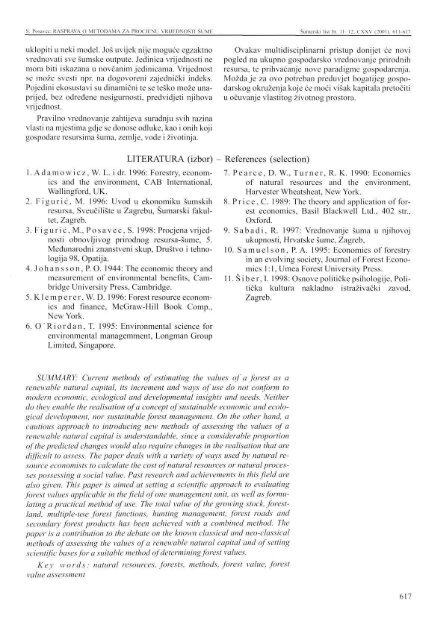Å UMARSKI LIST 11-12/2001 - HÅ D
Å UMARSKI LIST 11-12/2001 - HÅ D
Å UMARSKI LIST 11-12/2001 - HÅ D
Create successful ePaper yourself
Turn your PDF publications into a flip-book with our unique Google optimized e-Paper software.
S. Posavec: RASPRAVA O METODAMA ZA PROCJENU VRIJEDNOSTI ŠUME Šumarski list br. <strong>11</strong>-<strong>12</strong>. CXXV (<strong>2001</strong>), 6<strong>11</strong>-617<br />
uklopiti u neki model. Još uvijek nije moguće egzaktno<br />
vrednovati sve šumske outpute. Jedinica vrijednosti ne<br />
mora biti iskazana u novčanim jedinicama. Vrijednost<br />
se može svesti npr. na dogovoreni zajednički indeks.<br />
Pojedini ekosustavi su dinamični te se teško može unaprijed,<br />
bez određene nesigurnosti, predvidjeti njihova<br />
vrijednost.<br />
Pravilno vrednovanje zahtijeva suradnju svih razina<br />
vlasti na mjestima gdje se donose odluke, kao i onih koji<br />
gospodare resursima šuma, zemlje, vode i životinja.<br />
Ovakav multidisciplinarni pristup donijet će novi<br />
pogled na ukupno gospodarsko vrednovanje prirodnih<br />
resursa, te prihvaćanje nove paradigme gospodarenja.<br />
Možda je za ovo potreban preduvjet bogatijeg gospodarskog<br />
okruženja koje će moći višak kapitala pretočiti<br />
u očuvanje vlastitog životnog prostora.<br />
1. A d a m o w i c z, W. L. i dr. 1996: Forestry, economics<br />
and the environment, CAB International,<br />
Wallingford, UK.<br />
2. Figurić, M. 1996: Uvod u ekonomiku šumskih<br />
resursa, Sveučilište u Zagrebu, Šumarski fakultet,<br />
Zagreb.<br />
3. Figurić, M., Posavec, S. 1998: Procjena vrijednosti<br />
obnovljivog prirodnog resursa-šume, 5.<br />
Međunarodni znanstveni skup, Društvo i tehnologija<br />
98, Opatija.<br />
4. Johansson, P. O. 1944: The economic theory and<br />
measurement of environmental benefits, Cambridge<br />
University Press, Cambridge.<br />
5. Klemperer, W. D. 1996: Forest resource economics<br />
and finance, McGraw-Hill Book Comp.,<br />
New York.<br />
6. O'Riordan, T. 1995: Environmental science for<br />
environmental managemment, Longman Group<br />
Limited, Singapore.<br />
LITERATURA (izbor) - References (selection)<br />
7 Pearce, D. W., Turner, R. K. 1990: Economics<br />
of natural resources and the environment,<br />
Harvester Wheatsheat, New York.<br />
8 Price, C. 1989: The theory and application of forest<br />
economics, Basil Blackwell Ltd., 402 str.,<br />
Oxford.<br />
9. Sabadi, R. 1997: Vrednovanje šuma u njihovoj<br />
ukupnosti, Hrvatske šume, Zagreb,<br />
10. Samuel son, P. A. 1995: Economics of forestry<br />
in an evolving society, Journal of Forest Economics<br />
1:1, Umea Forest University Press.<br />
<strong>11</strong>. Siber, I. 1998: Osnove političke psihologije, Politička<br />
kultura nakladno istraživački zavod,<br />
Zagreb.<br />
SUMMARY: Current methods of estimating the values of a forest as a<br />
renewable natural capital, its increment and ways of use do not conform to<br />
modern economic, ecological and developmental insights and needs. Neither<br />
do they enable the realisation of a concept of sustainable economic and ecological<br />
development, nor sustainable forest management. On the other hand, a<br />
cautious approach to introducing new methods of assessing the values of a<br />
renewable natural capital is understandable, since a considerable proportion<br />
of the predicted changes would also require changes in the realisation that are<br />
difficult to assess. The paper deals with a variety of ways used by natural resource<br />
economists to calculate the cost of natural resources or natural processes<br />
possessing a social value. Past research and achievements in this field are<br />
also given. This paper is aimed at setting a scientific approach to evaluating<br />
forest values applicable in the field of one management unit, as well as formulating<br />
a practical method of use. The total value of the growing stock, forestland,<br />
multiple-use forest functions, hunting management, forest roads and<br />
secondary forest products has been achieved with a combined method. The<br />
paper is a contribution to the debate on the known classical and neo-classical<br />
methods of assessing the values of a renewable natural capital and of setting<br />
scientific bases for a suitable method of determining forest values.<br />
Key words: natural resources, forests, methods, forest value, forest<br />
value assessment<br />
617

















